We’ll get back to those questions in a minute, but first, it’s rant time.
The Truth About Search Engine Traffic from Google
Most marketers have a love-hate relationship with Google. The “hate” portion of it comes from us feeling like we are entitled to reap certain benefits from Google’s brilliant business model, i.e. we feel entitled to be found in their search engine results. In fact, nothing could be further from the truth. Google is a business. Its main goal is to generate revenue by serving its end user: a person who comes to Google to find information. It’s all about delivering the best search results in the most efficient way. And now that we are shifting more and more toward semantic search (more of that below), the best results will be served directly on Google.com, which will keep the searchers exactly where Google wants them – duh, on Google.com. 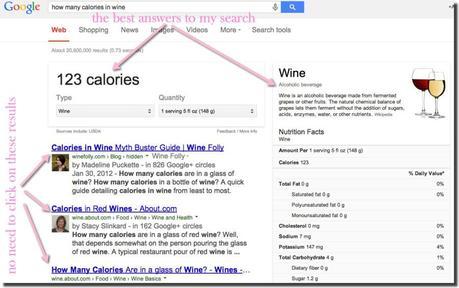 Getting bent out of shape about this simple truth doesn’t make it so. And here another simple truth to consider:
Getting bent out of shape about this simple truth doesn’t make it so. And here another simple truth to consider:
You just might be much better off not worrying about Google at all and focusing on other much more obtainable and reliable sources of traffic like:
- referral traffic from other blogs (you’ll need to seriously master the art of writing BIG content for that),
- social media (that’s where building relationships with people who will potentially carry your message to your target audience for you)
- or content sharing sites like Slideshare, YouTube, etc.
With that said, let’s move on to exploring the theory and practice of getting more search engine traffic for non-SEOs.
7 Keys to Getting More Search Engine Traffic
- SEO Traffic Key 1: Content – Go BIG or Go Home
- SEO Traffic Key 2: Google’s Semantic Search (& How Your BIG Content Fits in)
- SEO Traffic Key 3: Google+
- SEO Traffic Key 4: Authorship & Schema Markups
- SEO Traffic Key 5: Link Building Earning
- SEO Traffic Key 6: Mobile SEO
- SEO Traffic Key 7: Use Ignore Google Analytics
- One More for the Road: Keep up with SEO/Marketing News
- SEO Traffic Marketing Takeaway
SEO Traffic Key 1: Content – Go BIG or Go Home
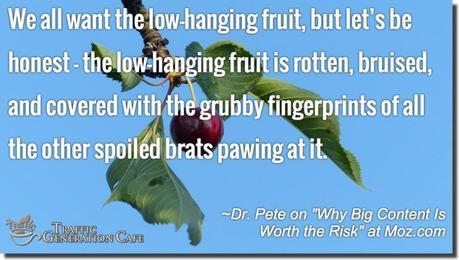 This one comes as no surprise: a website/blog won’t go too far without content – neither with Google, nor with your readers. However, just any content won’t do either. The kind of content Google is looking for is best defined as “deep” – the kind of in-depth content that:
This one comes as no surprise: a website/blog won’t go too far without content – neither with Google, nor with your readers. However, just any content won’t do either. The kind of content Google is looking for is best defined as “deep” – the kind of in-depth content that:
- establishes your expertise in your niche,
- distinguishes you from your peers,
- and keeps your readers coming back for more.
The kind of content that was described by Hannah Smith as Go Big or Go Home, by Dr. Pete in ‘Why Big Content Is Worth the Risk’ at Moz.com (quoted in the image above), and summed up in Big Wins that Last – Why Big Evergreen Content is the Best Content Strategy at siliconbeachtraining.co.uk.
Big content takes around 40 hours to produce.
The more time you spend on any given piece of content, the higher ROI that piece of content should produce as far as web traffic and resulting links. Hannah Smith used 40 hours as the average time to produce big content, while an okayish blog post would take around 4 hours from concept to execution – approximation, of course, but you get the point.
“Big content needs big concepts, but it doesn’t have to be lengthy.” ~ Dr. Pete
If the concept isn’t big enough, the content won’t work. Using Dr. Pete’s example, he spent 30-40 hours creating a 1-page 25-point usability checklist PDF (most marketers might be tempted to knock together a 1-page PDF in a couple of hours). The results were astounding, and the piece still receives tons of evergreen traffic – even three years after the original publication date: 
Big content can turn your business into a thought leader.
And that, my friend, is precisely what will separate you from the rest of the pack. In practical terms, big content results in more social media shares, links, thus better positioning and findability on Google and more long-term search engine traffic.
6 Practical Steps to Writing Big Content that Results in Big Traffic
- Establish a regular publishing schedule. How often should you publish? It depends on your niche – one size doesn’t fit all. However, a general guideline would be to publish at least twice a week.
- Focus on the quality of your posts. Gone are the days when publishing more content, whatever the quality, was in. Google wants you to spend more time on each post truly turning it into an exhaustive resource, even if it means publishing less frequently.
- Answer specific questions. The more specific your content is the more likely Google will rank it for queries related to the topic.
- Improve your existing content. Updating your existing posts, especially the ones that are popular with your readers or are currently ranked on search engines, with new information, resources, images might be time much better invested over writing new content.
- Improve your post formatting. Something so easy to do, yet so widely ignored by so many bloggers! Format your post with headings. Write shorter paragraphs. Use more bullet points. Cut out the fluff. Use visual aids (images, etc). Trust me: you are NOT insulting your readers’ intelligence by formatting your posts this way; rather you are giving them a way to get more out of your content faster.
- Create resource pages. Segregate your best posts on similar topics into comprehensive resource pages. Make sure to include the links to those pages in your sidebar, main navigation menu, or the footer. Examples of such pages:
- SEO Traffic 101: Simple Strategies to Getting More Search Engine Traffic
- Social Media Traffic 101: How to REALLY Get Traffic from Social Media
- How to Build an Email List 101
- Ana Loves: My Internet Marketing Rolodex
Learn More: Big Content Additional Reading List
The Advanced Guide to Conten Marketing – Neil Patel at quicksprout.com
Why You Should Blog Less and Update More – Michael Gray at graywolfseo.com
How I Get My Average Time on Page as High as 40 Minutes With Magnetic Content – Adam Connell at bloggingwizard.com
SEO Traffic Key 2: Google’s Semantic Search (& How Your BIG Content Fits in)
Write BIG content. We get it. But how do we get our BIG content to show up in Google’s search results? It comes down to understanding Google’s semantic search and applying its principles when writing our big content.
What is Google’s Semantic Search?
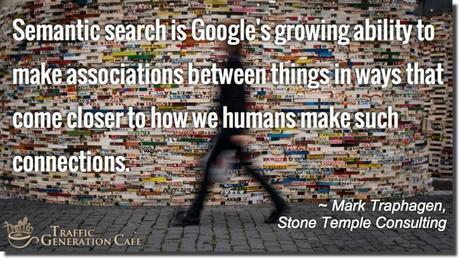 When you ask me, “How do I get to Market Street?“, I might hand you a bus schedule. I know that the bus schedule might contain the best solution to your problem, even though your question did not contain the words “bus” or “schedule.”
When you ask me, “How do I get to Market Street?“, I might hand you a bus schedule. I know that the bus schedule might contain the best solution to your problem, even though your question did not contain the words “bus” or “schedule.”
Example of Google Semantic Search
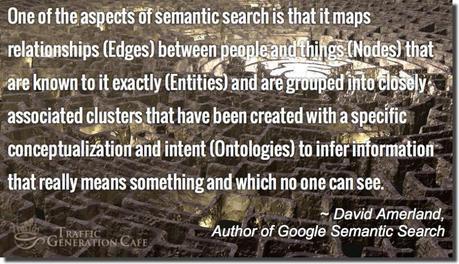 If you are still fuzzy on what Google Semantic Search really means, take a look at how it might work in a real Google search. The following example of Google Semantic Search comes from Martin Shervington‘s Google Semantic Search – what’s it all about? interview with David Amerland, the author of Google Semantic Search.
If you are still fuzzy on what Google Semantic Search really means, take a look at how it might work in a real Google search. The following example of Google Semantic Search comes from Martin Shervington‘s Google Semantic Search – what’s it all about? interview with David Amerland, the author of Google Semantic Search.
Say you go on the web and you put in “pizza restaurants“. And you do this search at 9 o’clock in the morning. At 9 o’clock in the morning Google knows, and especially if you use your mobile phone, that you are basically looking for information rather than actual pizza restaurants to order pizza. Because it’s unlikely that you’re going to need pizza at 9 o’clock in the morning. And it knows that because it knows your past search history, it knows your past search patterns, it knows where you normally do your search and where you’re doing it now. So it knows all that and it contextually creates a relevant result. You go now and do the same search, and you do the search at 7 in the evening. And you say pizza restaurants. Well it’s going to give you the nearest pizza restaurants where you can order a pizza because it knows the most likely thing now is that you’re starving hungry and you’re looking for a pizza restaurant to eat at. So it gives you more practical results rather than informational results because it makes that kind of assumption.
Does It Mean Keywords Don’t Matter Any Longer?
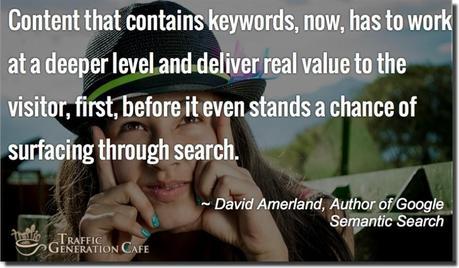 Not at all. Keywords are still important. True, Google Search is no longer keyword-based. It actually “understands” (remember the Pizza Restaurant example from above) the intent of your search queries and serves search results accordingly. Thus doing keyword research the way we used to and writing our posts around specific keywords is the way of the past. The difference today from years past is the shift from individual keywords to ideas/concepts.
Not at all. Keywords are still important. True, Google Search is no longer keyword-based. It actually “understands” (remember the Pizza Restaurant example from above) the intent of your search queries and serves search results accordingly. Thus doing keyword research the way we used to and writing our posts around specific keywords is the way of the past. The difference today from years past is the shift from individual keywords to ideas/concepts.
Keyword-based search ==> Concept-based search (semantic search)
If we focus our content around ideas/concepts instead of keywords, it has a potential to rank for 100s or 1000s of keywords at a time. To learn the practical ways of doing conceptual keyword research, I highly recommend you take a look at:
Keywords to Concepts: The Lazy Web Marketer’s Guide to Smart Keyword Research - Cyrus Shepard at Moz.com
What About On-Page Optimization?
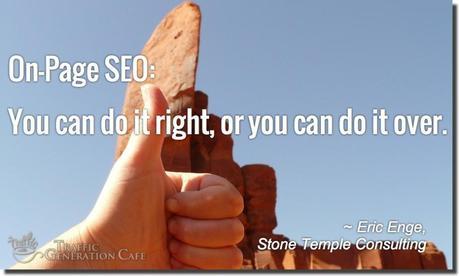 On-page SEO is here to stay. We still need to tell search engines what any given page is about and that’s exactly where on-page SEO comes in. And it’s not only for the search engine traffic either; proper on-page optimization also makes our content more readable and user-friendly. As AJ Kohn said in his Keywords Still Matter post:
On-page SEO is here to stay. We still need to tell search engines what any given page is about and that’s exactly where on-page SEO comes in. And it’s not only for the search engine traffic either; proper on-page optimization also makes our content more readable and user-friendly. As AJ Kohn said in his Keywords Still Matter post:
Using the keywords people expect to see can only help make your content more readable, which is still a tremendously undervalued aspect of SEO. Because people scan text and rarely read word for word.
To learn more about using on-page SEO to increase your search engine traffic, I highly recommend to take a look at:
A Visual Guide to Keyword Targeting and On-Page Optimization - Rand Fishkin at Moz.com
And to make your on-page optimization a lot easier, I suggested some tools to help you along here:
On Page SEO Plugin Domination: The Battle of the Best - at TrafficGenerationCafe.com
6 Practical Steps to Optimizing Your Content in Light of Google Semantic Search
- Be clear on the intent of your user and look for the questions behind the keywords. For instance, terms such as ‘credit cards’ and ‘compare credit cards’ would have been the focal point in the past, whereas with Google Semantic Search in mind, you’d be better of optimizing for terms like ‘how to compare credit cards’. Ensure that your content answers the 5 Ws & H: Who, What, When, Where, Why and How, i.e. the user’s intent.
- Use on-page SEO. Help the search engines and readers to better understand your pages.
- Write for that perfect person to read what you write. That’s the best way to reach your target audience.

- Use the language your clients use. If your clients and potential clients understand “blogging”, then use that language. If they understand “content marketing”, then use words that relate to content marketing.
- Develop a strong social presence. Semantic search requires a strong and constant social signal. An online business without a social presence is handicapped by default. (more on this below)
- Since Google now auto suggests complete sentences, use it as your keyword research. If Google thinks a query is best written a different way, users are going to be ‘pushed’ into results for these suggestions, like this image from Koozai.com shows:
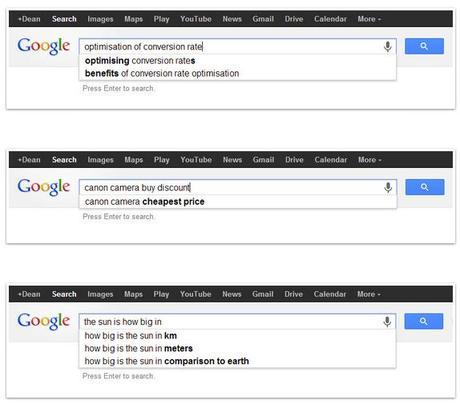
Learn More: Google Semantic Search Additional Reading List
“Google Semantic Search” (SEO Techniques) - David Amerland on Amazon.com
Semantic Search Seance – Eric Enge, Mark Traphagen, and David Amerland on Google+
Building SEO-Focused Pages to Serve Topics & People Rather than Keywords & Rankings – Whiteboard Friday - Rand Fishkin as Moz.com
Google Semantic Search – what’s it all about? - David Amerland & Martin Shervignton at plusyourbusiness.com
Keywords Still Matter – AJ Kohn at BlindFiveYearOld.com
99 Zingers – Tips That Will Challenge Your Digital Marketing Beliefs - Eric Enge at SearchEngineLand.com
SEO Traffic Key 3: Google+
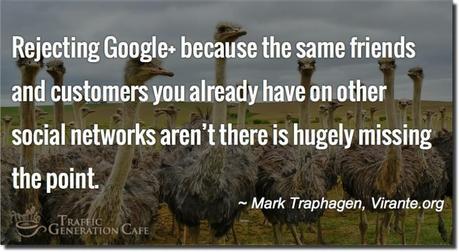 If SEO is the king of your search engine traffic, then Google+ is the voice behind the throne. Ignoring this simple fact doesn’t make it any less true.
If SEO is the king of your search engine traffic, then Google+ is the voice behind the throne. Ignoring this simple fact doesn’t make it any less true.  Google didn’t give birth to Google+ to give Facebook a run for their money, but to power semantic search and influence what appears in personalized search results. If gaining more website traffic through search engine marketing is part of your marketing strategy, then you can’t afford to ignore Google+. I can’t put it any more clear that this:
Google didn’t give birth to Google+ to give Facebook a run for their money, but to power semantic search and influence what appears in personalized search results. If gaining more website traffic through search engine marketing is part of your marketing strategy, then you can’t afford to ignore Google+. I can’t put it any more clear that this:
Google+ IS Google
One of the best posts on how Google+ relates to SEO and Google Semantic Search is this one by Brian Jensen – a highly recommended read:
Google+ Is Your Key To Visibility in Google Search
What About Facebook & Twitter & Their Influence on Search Engine Rankings?
Very conveniently, Matt Cutts has just released a video explaining that Google currently doesn’t do much indexing or ranking for Facebook or Twitter pages. Here’s why:
- They don’t want to start pouring engineering time into getting this data and then be blocked by Facebook or Twitter.
- They are worried they can’t crawl it fast enough to keep it up to date. Social data changes a lot and fast, so it may insult someone if they change their relationship status from one thing to another.
But Matt adds they will and do plan on doing this in the future. Here are some great insights from +Mark Traphagen on how to interpret Matt’s comments:
Google’s Matt Cutts: Understanding Social Identity on the Web is Hard – at StoneTemple.com
And more additional reading on the topic:
Does Facebook Activity Impact SEO? – Eric Enge at StoneTemple.com
5 Practical Steps to Leveraging Google+ for More (SEO) Traffic
These steps assume that you already have a Google+ profile set up (hard not to, considering that you need one to use any of Google’s multiple products).
- Optimize your Google+ profile to be found. You will put yourself in a better position to be discovered by your target audience, not just on Google+, but in Google search engine results (since Google+ posts are indexed and frequently show up as top results for any given search). If you do need a little help optimizing your profile, you can do no better than Stephan Hovnanian’s handy guide.
- Connect your Google+ profile with your main website, aka establish your Google Authorship (more on that below). Google Authorship is probably the biggest specific value of Google+ for SEO.
- Clearly identify your area of expertise. Your Google+ profile should be optimized for the topics you want to be known and ranked for. For instance, every time I search for anything related to Google+ and Google Authorship, I am bound to stumble upon +Mark Traphagen’s G+ posts – just goes to show the power of Google+ to establish yourself as an expert in your field and ultimately drive more search engine traffic back to your website than you could ever dream of with just your website alone:

- Treat your Google+ posts as micro-blogging vs your typical social media update. You won’t go far by simply sharing links to your own or even other writers’ publications. Engage your audience by giving them your own insight on the topic. I love it how +Ryan Hanley does it (you can read about it here How to Properly Share Content on Google Plus [Video]):
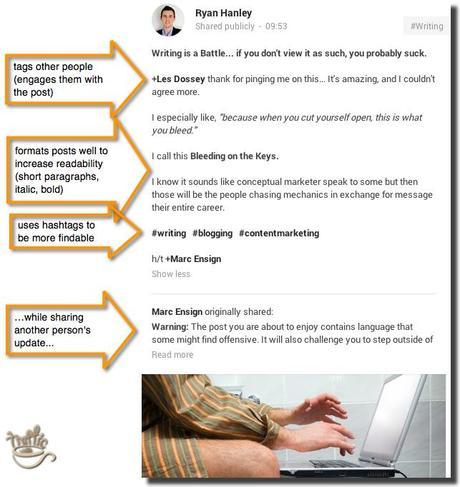
- Build relationships with influencers. Luckily, they make up a larger percentage of Google+ and when they find your content to be of value (shouldn’t be any other way, should it?), they will end up citing it and linking back to you, which might be worth dozens or even hundreds of mentions elsewhere.

Learn More: Google+ Additional Reading
There are several great authors who’ve become known as experts on all things Google+; here are just some of my favorites:
Google+ on Google+
Martin Shervington and other experts at PlusYourBusiness.com
Mark Traphagen on Google+
Ronnie Bincer on Google+ – The Hangout Helper
Stephan Hovnanian at WebsightHangouts.com
SEO Traffic Key 4: Authorship & Schema Markups

Google Authorship is the glue that pulls your content together from across the Internet into one singular identifiable author.
I can go on and on on the benefits of Google Authorship for search engine traffic, but the truth is this: it’s so essential and so easy to do that it’s a shame not to do it right now.
For more information on Google Authorship (and Google AuthorRank), take a look at these posts:
Google Author Rank: Are You Too Late? - at Traffic Generation Café
The Great Google Authorship Kidnapping: What Happened to Your Author Photo in Search? - Mark Traphagen at StoneTemple.com
Please, stop talking about AuthorRank - Gianluca Fiorelli at StateOfDigital.com
What About Structured Data Markup?
Structured Data Markup (aka Schema.org markup) is a string of code added to the pages on your site so that Google can better understand the data it contains. For example, if you mark up the reviews in your site, the next time Google crawls it, the review data will be available as rich snippets on the SERP. If all this sounds Greek, take a look at this post:
Schema Markup: How to Make Your Content More Clickable and Shareable - at TrafficGenerationCafe.com
Do you have to have structured data on your pages? Two sides of the coin here:
- Since it’s easy to do with a plugin like WP SEO Booster (that’s what I use for my markup at Traffic Generation Café) or, better yet, if you can mess with code, it’s silly not to. We’ll take any edge we can, right?
- On the other hand, semantic search is Google’s answer to the lack of structured data on the web. Google is in the business of extracting information from pages on the web that have unstructured data and indexing it in a structured data format in its semantic index.
So, if you don’t apply Schema markup to your site, don’t lose any sleep over it. Just make sure that you’re doing everything else right.
SEO Traffic Key 5: Link Building Earning
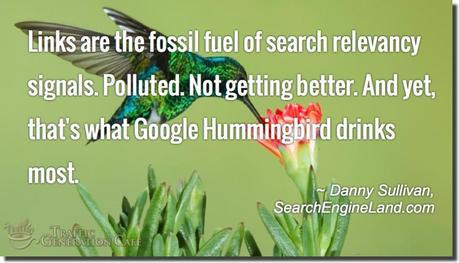
- Will links be less important in 2014?
- Is it possible that they could go away?
- Should I start link building, stop link building or just focus on social?
- How Will Google Hummingbird Impact Links?
All these questions fail to take into account the cornerstone truth about link building:
Don’t build links for Google — do it for traffic.
Links do still matter to your search engine rankings and traffic, but don’t forget the real reason links existed in the first place: to drive traffic. Before algorithms and search engines came into play, people linked out to other sites to encourage people to go there. That should always be your focus when building links. When another blogger mentions an epic post of yours (think BIG content), the referral traffic such a link can bring is most likely much more valuable that the slim influence it might have on your search engine ranking.
With that in mind, how do we build links in 2014?
Short answer: honestly. 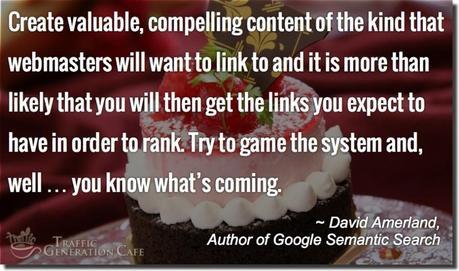 In the past couple of years, I’ve been watching very closely the roller coaster of Google algorithm changes, websites being penalized, SEOs screaming “The sky is a-falling!“, and website owners watching their sites drop out of Google rankings. After all that, I am very confident to say the following:
In the past couple of years, I’ve been watching very closely the roller coaster of Google algorithm changes, websites being penalized, SEOs screaming “The sky is a-falling!“, and website owners watching their sites drop out of Google rankings. After all that, I am very confident to say the following:
 Instead of link building, we should rather focus on link earning.
Instead of link building, we should rather focus on link earning.
More on Link Earning
According to The Art of Link Earning by Dan Petrovic (his post also contains great examples of each point), there are eight basic reasons links exist on the web:
- Attribution – Crediting original authors for using their content
- Reference – Quoting a statement from another author
- Definition – Linking to a page which defines a concept
- Expansion – Providing a path to an in-depth resource
- Identification – Disclosure of contextually relevant entities
- Example – Practical illustration of discussed entities and ideas
- Action – Inviting users to perform an activity
- Relationship – Engagement and connectivity based linking
Sounds to me like in order to earn links, the single most important thing we need to do is to create content that’s:
- relevant,
- shareable,
- quotable,
- actionable,
- findable.
The kind of BIG content we’ve talked about above. Top that with promoting your BIG content to help others discover it, and you should be well on your way to earn links that lead to immediate referral traffic, as well as long-term search engine traffic.
A Word on Guest Blogging
As you I am sure have heard, Matt Cutts has put yet another nail into guest blogging coffin: 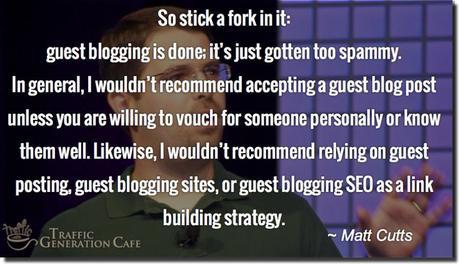 Of course, what he was simply saying is “Don’t guest blog for the sake of link building”, yet, not surprisingly, his post caused an uproar within marketing community. My favorite reaction to their over-reaction:
Of course, what he was simply saying is “Don’t guest blog for the sake of link building”, yet, not surprisingly, his post caused an uproar within marketing community. My favorite reaction to their over-reaction: 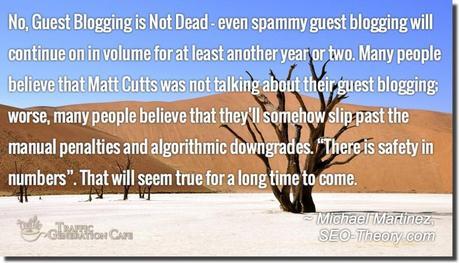 Do you want to write guest posts for the sake of referral traffic? By all means. Do you want to write guest posts to establish your expertise in your niche? Go for it. Just don’t do it for the sake of pointing a bunch of unnatural (self-created) links to your site. And if you do, do it knowing and accepting the risks.
Do you want to write guest posts for the sake of referral traffic? By all means. Do you want to write guest posts to establish your expertise in your niche? Go for it. Just don’t do it for the sake of pointing a bunch of unnatural (self-created) links to your site. And if you do, do it knowing and accepting the risks.
8 Practical Steps to Earning Links that Result in More Traffic
- Write the kind of content others would want to link to. This might sound harsh to some, but I love what Michael Martinez said on the topic – just the kind of “encouragement” I need to strive to write better:

- Build relationships ON your blog. Respond to blog comments. Respond to emails. Respond to responses from blog comments and emails. Visit your readers’ blogs. Give away your expertise and then some. Link out to other bloggers who earned links by providing exceptional content your readers might find relevant.
- Build relationships OFF your blog. See the Google+ section above, whatever your niche. Build presence on other social networks your target audience hangs out at. Generously share other authors’ expertise with your followers.
- Leverage different forms of content. This is one of the most underutilized ways to earn links and traffic and I talked about it at length in Content Marketing Leverage System: How to Multiply Your Reach. Do you like to write posts? Add a SoundCloud track for those readers who prefer to listen on the go. Like to do videos? Turn them into a Slideshare presentation for those readers who prefer to consume your content at their own pace. Repurposing content that way will retain your current readers, gain new readers from referral sites (referral traffic), and earn you links that might ultimately help you to get more search engine traffic long term. Just look at all the traffic I got in 2013 by simply creating Slideshare presentations based on my existing posts:
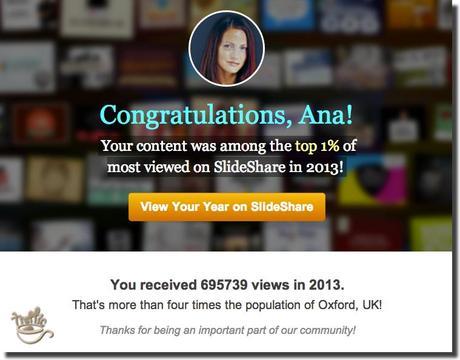
- Let anchor texts happen naturally. Let webmasters link to you with whatever anchors they wish; diversity and naturality are the key.
- Relevance is the New PageRank. A link that comes from a relevant to your niche website, but a low PR page will most likely do a lot more for your rankings that a PR7 link from a spammy directory.
- Speaking of PageRank: it’s alive and kicking. According to Danny Sullivan, ”PageRank is one of over 200 major “ingredients” that go into the Hummingbird recipe. Hummingbird looks at PageRank — how important links to a page are deemed to be — along with other factors like whether Google believes a page is of good quality, the words used on it and many other things.”
- Quality over quantity. This one deserves to be repeated: a few quality links from relevant authority sites will have a much bigger impact than hundreds of links from “made for guest blogging” blogs.
Learn More: Link Building Additional Reading
Ten Commandments of Link Building – Eric Ward at EricWard.com
Link Building is Not Illegal (or Inherently Bad) With Matt Cutts - Eric Enge at StoneTemple.com
Link Building Means Earning “Hard Links” Not “Easy Links” - Danny Sullivan at SearchEngineLand.com
Link Building Strategies – The Complete List Jon Cooper at PointBlankSEO.com
The Death of Link Building and the Rebirth of Link Earning – Whiteboard Friday – Rand Fishkin at Moz.com
SEO Traffic Key 6: Mobile SEO
As much as it pains me to admit it, I am not nearly as well-versed in Mobile SEO as I’d like to/should be. I suppose it just means that both of us have a lot of work to do to catch up, right? So what’s all the noise about? Here’s what: the number of mobile share of search engine organic searches (published by RKG):  Here’s another one to give us a kick in the rear: Kelsey Group has projected that by 2015 there will be more local searches coming from smartphones than PCs in the US. As this article from SocialMediaToday.com states, when Google announced Hummingbird, they referenced mobile by starting sentences with phrases like
Here’s another one to give us a kick in the rear: Kelsey Group has projected that by 2015 there will be more local searches coming from smartphones than PCs in the US. As this article from SocialMediaToday.com states, when Google announced Hummingbird, they referenced mobile by starting sentences with phrases like
“You can pull up your phone and …”
The announcement also centered around the updates and improvements to their mobile app’s search functionality saying
“It’s cleaner and simpler, optimized for touch” and “results (are) clustered on cards so you can focus on the answers you’re looking for.”
Bottom line: ready or not, Mobile SEO is becoming an integral part of our quest for search engine ranking traffic.
Learn More: Mobile SEO Additional Reading
Mobile SEO best practices for 2014: 11 tips to drive more traffic to your mobile site – at MobiThinking.com
SEO: Mobile Search – mobile SEO column at SearchEngineLand.com
Mobile SEO Resources – Aleyda Solís at aleydasolis.com
Know of any other Mobile SEO resources that non-SEOs can understand? Mention them in the comments please.
SEO Traffic Key 7: Use Ignore Google Analytics
Now that we are done with the search engine traffic essentials, there are two more points I’d like to mention before I let you go. The first one would be to avoid obsessing with Google Analytics. Sometimes too much information is just that: too much information. I am not saying don’t track your work at all; just take the “less is more” approach to analytics reporting. As Michael Martinez says in his One Year Without Google Analytics post: 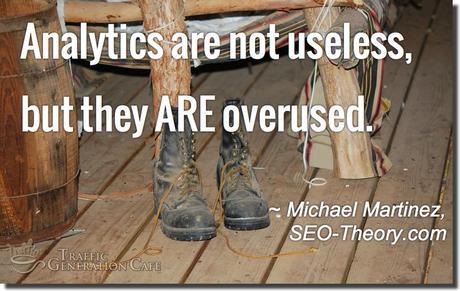 As an alternative to burying yourself in stats, allow me to suggest you download a few custom Google Analytics dashboards with just a click of a button as described in this post:
As an alternative to burying yourself in stats, allow me to suggest you download a few custom Google Analytics dashboards with just a click of a button as described in this post:
5 Custom Google Analytics Dashboards in 5 Minutes [Free Downloads] – at TrafficGenerationCafe.com
With those dashboards, you’ll be able to see/track all the stats that matter without being intimidated by or inundated with too many stats
One More for the Road: Keep up with SEO/Marketing News
As I mentioned in the beginning of this post that seems to never end, what works today might not work tomorrow. Just when you feel like you are on top of your game, the rules change, and you find yourself scrambling to stay afloat. That’s why staying on top of the latest marketing news that might impact your business is so crucial. I do realize that our sincere desire to keep up with the changes and the fact that 24 hours per day just refuse to stretch no matter how much we want them to, here are some helpful resources to help you do a better job of it.
1. Stay on Top of Marketing News with Weekly Marketing Skinnies
Don’t have the time to read all the marketing news, blog posts, announcements, and other content related to SEO/social media/online marketing published each week? I’ve got you covered. I sift through trillions (well, hundreds) of online publications to stay on top of marketing news that might impact your online business and publish them weekly at Traffic Generation Café. All you need to do is to enjoy your perfectly brewed Saturday morning cup of coffee while perusing the most important marketing headlines for the previous week. Better yet, join thousands of other Traffic Generation Café readers, and receive your Weekly Marketing Skinnies in your inbox on Saturday morning. Plus, you’ll get complimentary access to my ”Mommy, Where Does My Traffic Come From?” traffic hacks report and traffic hacks newsletter:

"Ana has a unique insight into running an internet business."
- Yaro Starak, Entrepreneurs-Journey.com
2. Join Me on Google+
I also share a lot of marketing news as well as the best posts I read throughout a week on my Google+ profile. To read them as they come out and stay ahead of your competition, as well as become a social media star and share the best with YOUR followers (you’d be surprised how much it’ll do for your credibility and online presence!), join me there:
Plus, remember how important to your Google search engine traffic Google+ is… You can also subscribe to my G+ feed through your RSS reader of choice; just add the following link like with any normal blog RSS feed: http://tgcafe.it/gplus-feed
3. Create Alerts to Notify You of Fresh Marketing News
For the sake of giving you an alternative to attaching you to my hip (like reading MY blog to catch up on the news, or following me on MY Google+ profile, or joining MY newsletter readers), you can also do a little bit of legwork of your own and set up all sorts of alerts to notify you as news stories important to your business come out. You can do it with:
- Google Alerts or
- Talkwalker Alerts.
Of course, there are many more similar sites, but less is more, right? Both Google Alerts and Talkwalker Alerts work very similarly, but I still suggest you use them both: neither one of them is as exhaustive as they could be on their own, but together they should provide you with all the information you ask for. Here’s an example of what kind of searches I have saved in my Google Alerts: 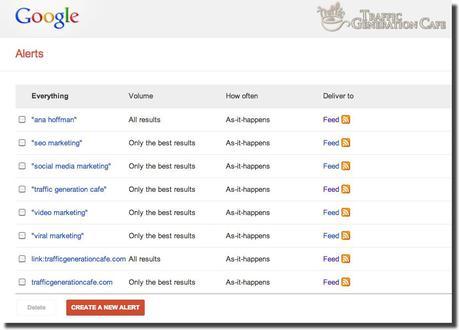 Once I have the alerts set up, I get the feed URLs (you can see them in “Deliver to” column) and add them to Feedly, which is what I use as my RSS reader.
Once I have the alerts set up, I get the feed URLs (you can see them in “Deliver to” column) and add them to Feedly, which is what I use as my RSS reader.
SEO Traffic Marketing Takeaway
No matter how I look at it, if you really want to get any search engine traffic from Google now or in the future, here are your options:
- Follow my 7 keys to search engine traffic as outlined in this post, then cross your fingers hoping it’ll be enough. Just being completely honest and transparent here.
- Become an SEO expert and REALLY learn what it takes to stay on top of your search engine rankings. Unrealistic for most of us, since we simply won’t have enough time to actually run our businesses.
- Hire a REPUTABLE SEO company like Stone Temple Consulting. Expect to drop some serious bucks, but at least you’ll have a much better shot at Google traffic, which might be a very healthy move for your bottom line. Just in case there are ANY doubts, these kinds of SEO services are to be avoided at ALL COST:
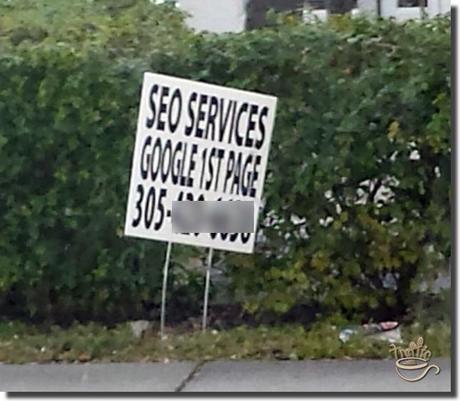
And once again, please remember that Google search engine traffic is far not the only or the best game in town when it comes down to website traffic generation. Pick up a free copy of my ”Mommy, Where Does My Traffic Come From?” guide and I’ll prove it to you. Happy (website) trafficking,



COMMENTS ( 4 )
posted on 24 January at 17:23
Along with incomes, earnings as well as money, the worth of your company is a function of your growth trajectory as well as your repeatable, exclusive processes.
posted on 18 October at 06:11
It's in fact very difficult in this busy life to listen news on TV, therefore I only use world wide web for that purpose, and get the newest information.
posted on 27 August at 22:10
For most recent news you have to go to see world-wide-web and on the web I found this web site as a finest website for most recent updates.
posted on 26 August at 11:03
My breother suggested I might like this blog.
He was entirely right. This post actually made my day.
You cann't imagine simply how much time I had spent forr this information! Thanks!
posted on 04 February at 15:50
Hi Ana, to keep you updated on our product: Talkwalker Alerts are now also available on HootSuite! To try it out yourself, simply install the Talkwalker Alerts app on HootSuite to monitor and share content the fastest way in one single platform. More info at http://bit.ly/1aW01hb - let me know how it works for you :)